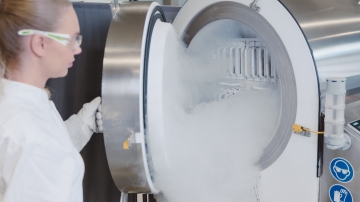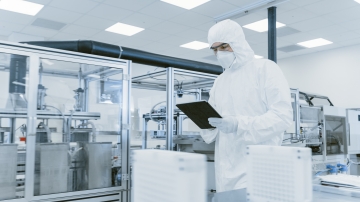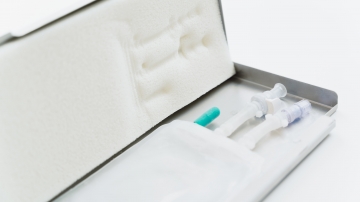What is cell viability and cell proliferation?
Table of contents
ShowCell viability and cell proliferation are two fundamental concepts in the realms of science and medicine that play a crucial role in understanding the behavior of cells. While cell viability describes the amount of living and functioning cells in a sample, cell proliferation describes the ability of cells to replicate themselves. Both parameters are essential in cell banking, where smaller amounts of viable cells need to be multiplied after cryopreservation to create larger working cell banks.1 2
In this article, we will have a more detailed look at both concepts.1 2
Cell viability
Cell viability refers to the number of cells with the ability to remain alive and functional within a given environment or experimental conditions. It is a critical indicator of cell health and functionality. Cells that are viable can carry out their intended functions effectively, while non-viable cells may be damaged, dying, or already dead.3
Methods to assess cell viability
Scientists employ various techniques to assess cell viability accurately. One of the most common methods is the use of vital dyes, which can distinguish between live and dead cells based on their membrane integrity.
Another approach involves measuring metabolic activity or ATP (adenosine triphosphate) levels within cells, as viable cells actively produce ATP to support their functions.
Factors affecting cell viability
Cell viability can be improved or worsened by multiple factors, such as:
- temperature
- pH
- nutrient availability
- exposure to toxins or drugs
Maintaining optimal culture conditions is crucial for ensuring high cell viability during experiments or in industrial applications.

Cell proliferation
Cell proliferation refers to the process of cell division and reproduction, leading to an increase in the number of cells. This natural mechanism plays a vital role in growth, tissue repair, and maintenance of cellular homeostasis. Cells proliferate to replace damaged or old cells and to support organ development during growth stages – a process that can facilitated in vitro as well. However, it does not undermine the importance of cell viability assessments, where, for instance, the impact of environmental factors on cell health can be determined.4
Techniques to measure cell proliferation
Scientists have developed several methods to measure cell proliferation accurately. One common approach is the use of BrdU (bromodeoxyuridine) or EdU (5-ethynyl-2'-deoxyuridine) incorporation assays, which detect actively dividing cells by labeling their newly synthesized DNA.
A different approach in measuring cell proliferation is analyzing the expression of specific proliferation markers through immunostaining.
Regulation of cell proliferation
Cell proliferation is tightly regulated by various signaling pathways and factors. The cell cycle controls the orderly progression of cell division, ensuring that each phase occurs at the right time and under the appropriate conditions. In vivo, dysregulation of cell proliferation can lead to abnormal growth and contribute to diseases, including cancer, whereas in vitro studies may fail or be delayed due to irregular cell proliferation.
Key similarities between cell viability and cell proliferation
While both concepts are related to cell behavior, cell viability focuses on cell health and survival, whereas cell proliferation centers on cell division and growth.
Maintaining viability is essential in ensuring the reliability of experimental results, while understanding proliferation is crucial for tissue regeneration and combating diseases like cancer.
Nevertheless, both cell viability and cell proliferation are important parameters in cell banking, where manufacturers aim to preserve, modify and multiply various cell types for different applications.
Read more on the difference between cell viability and cytotoxicity
Importance in research
In scientific research, studying cell viability and proliferation yields valuable insights. Researchers can assess the effects of various compounds on cell health and survival, aiding in drug discovery and toxicity testing. Additionally, investigating cell proliferation mechanisms helps uncover potential targets for therapeutic interventions.
Cell viability and proliferation are essential parameters in cell banking and particularly significant in fields like pharmacology, biotechnology, and regenerative medicine, where cell-based therapies and tissue engineering are advancing rapidly.
Methods to enhance cell viability and proliferation
In laboratory settings and medical applications, researchers and clinicians aim to optimize cell viability and proliferation. Providing cells with the right nutrients, maintaining appropriate culture conditions, and minimizing exposure to stressors contribute to enhanced viability.
Similarly, promoting cell proliferation can be achieved through growth factors, cytokines, or small molecules that activate specific signaling pathways. For example, in tissue engineering, scaffolds and biomaterials can be designed to support cell proliferation and tissue formation.
However, cell viability and proliferation not only depend on added reagents, but also on processing and storage conditions. Considering the risk of cell degradation, for instance, elaborate temperature control has to be established throughout production, shipping and storing. This is why companies like Single Use Support have specialized in dedicated equipment for automated fluid and cold chain management in cell banking, facilitating cGMP cell banking and long-term preservation of cellular material for various applications.
- Cell Proliferation and Cytotoxicity Assays, http://dx.doi.org/10.2174/1389201017666160808160513, Published 2016-08-15
- Cell proliferation – Definition, Types, differentiation, assay, diseases, https://microbiologynote.com/cell-proliferation-definition-types-differentiation-assay-diseases/, Published 2023
- Cell Proliferation and Cytotoxicity Assays, http://dx.doi.org/10.2174/1389201017666160808160513, Published 2016-08-15
- Cell proliferation – Definition, Types, differentiation, assay, diseases, https://microbiologynote.com/cell-proliferation-definition-types-differentiation-assay-diseases/, Published 2023










